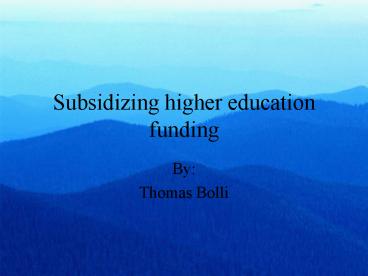Subsidizing higher education funding
1 / 18
Title: Subsidizing higher education funding
1
Subsidizing higher education funding
- By
- Thomas Bolli
2
Annual Statictics
- -Direct expenditure for higher education
- State governments 87.8 billion
- Local governments 14.1 billion
- -Average student subsidy per year 8200
- Sources 1. http//www.census.gov/prod/2001pubs/st
atab/sec04.pdf, 12 - 2. Journal of Economic Perspectives, Vol. 13,
Nr. 1 (Winter 1999), 19, by Gordon C. Winston - Subsidies, Hierarchy and Peers The Awkward
Economics of Higher Education
3
Winners and Losers
- Winners -Universties
- -Students
- -Professors
- -Firms
- -Society
- Losers -Taxpayers
4
Economic Justification
- Externalities
- Prisonner Dilemma
5
1. Externalities
- Positive Externalities
- -Spillover effect to the society
- -Increased human capital
- -Increased research
- -Increased probability of successful
research
6
1. Externalities (continued)
- 2. Negative externalities
- -Investion in human capital is risky for the
privat market - Sources Journal of Economic Perspectives, Vol.
7, Nr. 3 (Summer 1993), - 194, by Alan B. Krüger and William G. Bowen
- Policy Watch Income-Contingent College Loans
7
2. Prisonner Dilemma
8
2. Explanation Prisonner Dilemma
- The firms can choose between investing into human
capital or not investing. Since the investment is
costly, their rational choice, independent of the
choice of the other firms is not to invest into
human capital. Since all the firms face this
situation, the choice of not investing is the
Nash Equilibrium.
9
Graphical Representation of the Externalities
10
Externalities Diagram Analysis
- -MSCltMPC because of the risk and the prisonner
dilemma - -MSBgtMSC because of the spillover effect
- -Qmarket is the quantity produced in a free
market, where MPCMPB - -Qefficient is the quantity at which MSCMSB
11
Externalities Diagram Analysis (continued)
- -QefficientltQmarket due to externalities and the
prisonner dilemma - -Deadweight loss shaded area
- ½ (Qefficient-Qmarket) (Pe-Pm)
12
Ways to reduce the Externalities
- Subsidizing of supply
- Subsidizing of demand
- Combined subsidizing
- Compulsion education
- Supply of education
13
Problems of Solutions
- The supply of education and compulsion education
both lead to the problem of government failure. - The subsidizing of demand has the disadvantage,
that the choice of the beneficials leads to the
problem of government failure and so does the
combined subsidizing.
14
Recommended Solution
- Subsidizing of supply with general tax revenues.
The problem of the choice between benficials is
delegated to the universities, which reduces the
problem of government failure as much as possible.
15
Effect of Subsidy of Supply
16
Analysis of the effect diagram
- The MPC curve lowered by the amount of the
subsidy. This leads to the curve - MPC-Subsidy. This curve crosses the MPB at
Qefficient. The external costs are internalized
and the efficient amount of education is
produced. The deadweight loss is prevented from
occuring.
17
Analysis of the effect diagram (continued)
- The cost imposed on the tax payers
- amount of subsidy
- (Pt-Ps) Qefficient
18
The End































